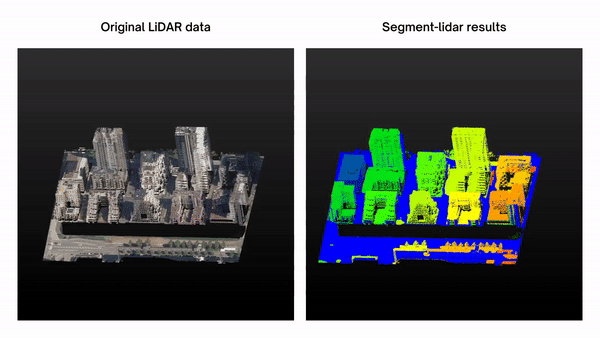A package for segmenting LiDAR data using Segment-Anything Model (SAM) from Meta AI Research.
Project description

segment-lidar
Python CLI for segmenting LiDAR data using Segment-Anything Model (SAM) from Meta Research.
This package is specifically designed for unsupervised instance segmentation of aerial LiDAR data. It brings together the power of the Segment-Anything Model (SAM) developed by Meta Research and the segment-geospatial package from Open Geospatial Solutions. Whether you're a researcher, developer, or a geospatial enthusiast, segment-lidar opens up new possibilities for automatic processing of aerial LiDAR data and enables further applications. We encourage you to explore our code, contribute to its development and leverage its capabilities for your segmentation tasks.
Installation
We recommand using python==3.9. First, you need to install PyTorch. Please follow the instructions here.
Then, you can easily install segment-lidar from PyPI:
pip install segment-lidar
Or, you can install it from source by running the following commands:
git clone https://github.com/Yarroudh/segment-lidar
cd segment-lidar
python setup.py install
Usage of the package
After installation, you have a small program called segment-lidar. Use segment-lidar --help to see the detailed help:
Usage: segment-lidar [OPTIONS] COMMAND [ARGS]...
A package for segmenting LiDAR data using Segment-Anything from Meta AI
Research.
Options:
--help Show this message and exit.
Commands:
create-config Create a configuration YAML file.
segment Segment LiDAR data.
The package reads .las or .laz file, then perform instance segmentation using segment-geospatial or/and segment-anything algorithms. The user should first create the configuration file by running:
segment-lidar create-config -o config.yaml
This will create a configuration file as follow:
algorithm: segment-geospatial
classification: null
csf_filter: true
csf_params:
class_threshold: 0.5
cloth_resolution: 0.2
interations: 500
slope_smooth: false
device: cuda:0
image_path: raster.tif
input_path: pointcloud.las
model_path: sam_vit_h_4b8939.pth
model_type: vit_h
output_path: classified.las
resolution: 0.15
sam_geo:
automatic: true
box_threshold: 0.24
erosion_kernel_size: 3
sam_kwargs: true
text_prompt: null
text_threshold: 0.3
sam_kwargs:
crop_n_layers: 1
crop_n_points_downscale_factor: 1
min_mask_region_area: 1000
points_per_side: 32
pred_iou_thresh: 0.95
stability_score_thresh: 0.92
The second step is to run the segmentation:
segment-lidar segment --config config.yaml
The resulted point cloud contains a new scalar field called segment_id. For visualization and further processing, we recommand using CloudCompare.
Testing data
For testing purposes, you can download a sample here: pointcloud.las.
This data was retrieved from AHN-4. For more data, please visit AHN-Viewer
Configuration
algorithm: algorithm to use for instance segmentation [segment-geospatial/segment-anything].model_path: path of the model checkpoints. See segment-anything repository for models.model_type: SAM model version [vit_h/vit_l/vit_b].device: if cpu the prediction will use the CPU, if you have cuda, use cuda:0 instead for GPU.input_path: path to your input .las/.laz file.output_path: path to your output .las/.laz file. The results will be saved in this file.image_path: path to the resulted image. The segmentation results of SAM or segment-geospatial will be saved in this file.classification: specify the class number you want to segment. This will limit instance segmentation to specified class.csf_filter: apply ground filtering using cloth simulation filter.csf_params: refer to Cloth Simulation Filer for additional information.resolution: resolution of the image created from the point cloud.sam_kwargs: refer to segment-anything for additional information.sam_geo: refer to segment-geospatial for additional information.
Please note that the actual version is a pre-release and it's under tests. If you find any issues or bugs, please report them in issues section. The second version will have more advanced features and fonctionalities.
Related repositories
We would like to express our acknowledgments to the creators of:
Documentation
Coming soon.
License
This software is under the BSD 3-Clause "New" or "Revised" license which is a permissive license that allows you almost unlimited freedom with the software so long as you include the BSD copyright and license notice in it. Please refer to the LICENSE file for more detailed information.
Author
This software was developped by Anass Yarroudh, a Research Engineer in the Geomatics Unit of the University of Liege. For more detailed information please contact us via ayarroudh@uliege.be, we are pleased to send you the necessary information.
Project details
Release history Release notifications | RSS feed
Download files
Download the file for your platform. If you're not sure which to choose, learn more about installing packages.
Source Distribution
Built Distribution
Hashes for segment_lidar-0.1.3-py3-none-any.whl
| Algorithm | Hash digest | |
|---|---|---|
| SHA256 | b6f1f349b6a0d04303fbf71ecbdd5bb1148db45122ff029ab494fbc09f099509 |
|
| MD5 | 8f0202272719c9499ee2e1744fc03d2d |
|
| BLAKE2b-256 | 76411fc9641d277662430ed443bb237966e8161a00208ff96ae4fd83280a1278 |














